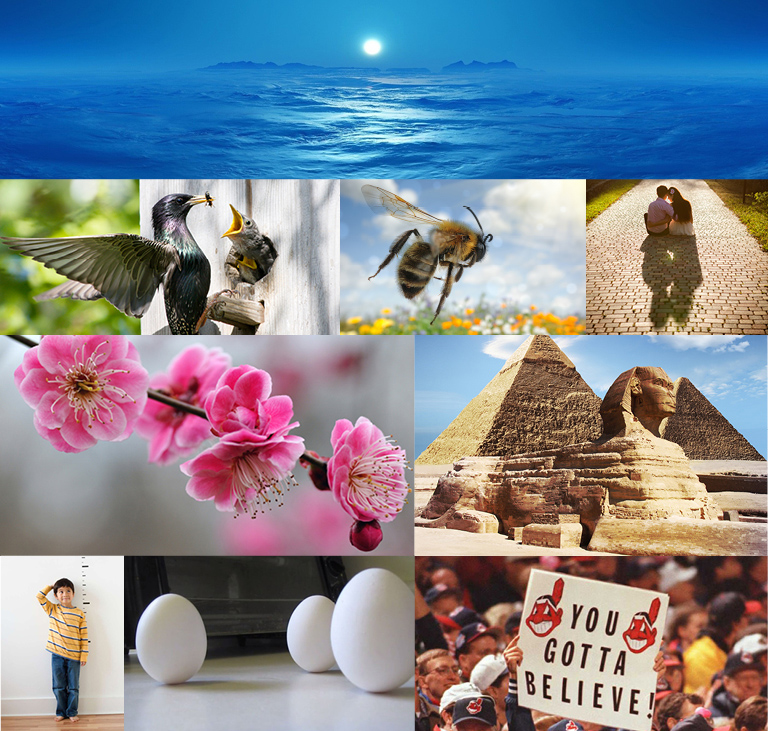Birds, Bees, Baseball

(top) View of the sun from the north pole in springtime. All day and all night. (row two l to r) The birds; the bees; etc. (row three l to r) Nothing says spring like cherry blossoms; Did you know that the face of the Great Sphinx points directly toward the rising sun on the spring equinox? How did they figure that out? (row four l to r) Fact: children grow faster in the spring; True or false: eggs balance on their ends during the spring equinox; Go Tribe!!!
Got that “can’t wait” feeling? This week marks the official start of spring – and it can’t have come soon enough. We’ve been teased this year, enjoying days in the 70’s, and then snow storms in the teens. As our parking lot begins to thaw, and the plow piles melt away, I find myself enjoying the sights and smells of spring. For my trivia buffs, here are some fun facts about spring, and why it is so great turning the calendar page over to warmer weather. Thanks to factretriever.com. Enjoy!
- The first day of spring is called the vernal equinox. The term vernal is Latin for “spring” and equinox is Latin for “equal night.” The word “season” is from the Latin sationem meaning “sowing” or “seed time.”
- The fall and spring equinoxes are the only two times during the year when the sun rises due east and sets due west. The first day of spring in the Southern Hemisphere is the first day of fall in the Northern Hemisphere.
- On the first day of spring, a person at the North Pole would see the sun skimming across the horizon, beginning six months of uninterrupted daylight. A person at the South Pole would see the sun skimming across the horizon, signaling the start of six months of darkness.
- If Pope Gregory XIII would not have established the Gregorian calendar, which most of the world now observes, in 1582, then every 128 years the vernal equinox would have come a full calendar day earlier, eventually putting Easter in midwinter.
- Spring almost always arrives on March 20 or 21, but sometimes on the 19th. The reason the equinoxes and solstices don’t always come on the same day is that Earth doesn’t circle the sun in exactly 365 days.
- While the spring equinox typically occurs on March 20 or 21, meteorological spring begins on March 1, a month when average temperatures increase by 10 degrees over the month.
- A flurry of gorgeous birds migrating back from South America and the southern US will be flying to your very own backyard. Species like the pine warbler, hooded warbler, Vesper sparrow and common yellowthroat will arrive as early as March, and every week, more and more species will arrive until late May. During the spring migration, a feeder might be a useful source of food for traveling birds.
- During the spring, birds are more vocal as they sing to attract mates and warn away rivals. Look for an increase in red-winged blackbirds. Just like lots of teen age boys and girls!
- Children actually grow faster in the spring than during other times of the year.
- If Earth rotated on an axis perpendicular to the plane of its orbit around the sun rather than on a 23.4º tilt, there would be no variation in day lengths and no variation in seasons.
- Pay close attention to those trees in your back yard, because soon, you will begin to notice small buds opening up for pollination. The silver maple is one of the first trees to have their buds fully emerge in the spring time, followed by the red maple in early March. Tiny red and golden flowers will emerge from these buds where fresh, lime green leaves will eventually appear.
- The first spring flowers are typically lilacs, irises, lilies, tulips, daffodils, and dandelions.
- Honeybees are more likely to swarm during the spring. They swarm as a way to start new colonies from successful ones. Surprisingly, swarming honeybees are very docile and the most friendly they will ever be all year.
- The myth that it is possible to balance an egg on its end on the spring equinox is just that: a myth. Trying to balance an oval-shaped object on its end is no easier on the spring equinox than on any other day.
- In China, the coming of spring coincides with celebrations for the Chinese New Year. The holiday falls on the first day of the first lunar month, in January or February. For the Japanese, the opening of the cherry blossom, Japan’s national flower, in March or April signals the start of spring.
- The early Egyptians built the Great Sphinx so that it points directly toward the rising sun on the spring equinox.
- Every year on the first day of spring, people in Poland gather to burn an effigy and throw it in the river to bid winter farewell.
- Remember all real Clevelander’s know the “official” start of spring, with the crack of a bat on Opening Day.



Leave a Reply
Want to join the discussion?Feel free to contribute!